Bona’s unique refill pouch enhances the consumer’s experience
A new spouted stand-up pouch, typically seen in the wine category, is now adding consumer convenience and user functionality to bulk refills for Bona’s floor cleaners—and minimizes the product’s environmental footprint by replacing a heavier-weight rigid package.
Like nearly every successful packaging development, this project wasn’t just a simple drop-in package replacement. This premade pouch with comfort-carry handles, which holds 160 ounces or about 10 pounds of ready-to-use product, is different in several ways. For example:
• It is made from four webs of film (for several good reasons, outlined below).
• It dispenses the liquid cleaning product from a spout at the bottom of the pouch (instead of the typical top corner position of other refills).
Dan Smith, new product development engineer at Bona U.S., led this package development project in tandem with Bona’s product marketing team, and also worked closely with packaging vendors to ensure quality standards were met. Smith is a consumer product development maven with more than 20 years of experience in leading the creation of innovative products—from napkin sketch to production start-up—for the automotive, telecommunications and consumer product industries.
Smith tells Packaging Digest more about the pouch’s unusual construction and why the spout is at the bottom of the stand-up pouch. Carlos Boku Cornejo, sales director at pouch supplier Innovative Packaging Solutions (IPS), also provides technical details about the pouch manufacturing.
Why is there a need to enhance the refill experience for consumers?
Smith: Consumer feedback revealed that while our large refill-size products were popular due to cost savings, the packaging was cumbersome. Particularly when refilling our mop cartridge, the process didn’t meet our ease-of-use promise to consumers. When the wide mouth of the old 160-oz refill met the smaller opening of the cartridge, it was too easy to spill product. We also tested internally and, true to Bona’s commitment to innovation, we knew we could do better.
Why identify this as a refill pouch? Can’t it be used as the primary package?
Smith: Most Bona products are ready-to-use. We rarely offer a cleaner concentrate because the power of the Bona cleaner is the unique formulation of the solution. It wouldn’t make sense to have this refill pouch as a primary package as we have invested a great deal of innovation into the spray delivery mechanisms of our cleaners and mops.
Why a “soft” package (flexible versus rigid)? Is it better for ecommerce delivery? Is it better from an environmental viewpoint?
Smith: The soft packaging uses less material than a more rigid package. One of Bona’s key tenets is to also take environment into consideration, so this package uses 50% fewer materials (by weight) than our previous package, a high-density polyethylene (HDPE) bottle. That translates into less waste in landfills for those who don’t or cannot recycle.
The soft packaging also tested better with consumers as a better visual appeal of the product.
Copy on the back of the pouch says that it uses 50% less packaging material by weight compared to the previous rigid bottle. Why was this important to include on the package?
Smith: This goes back to our brand promise at Bona. We want consumers to know we are keeping the environment top-of-mind in our packaging and products.
How important was sustainability in the design of this package? More or less so than the consumer experience?
Smith: In this case, we were looking to improve both the consumer experience and the impact on the environment. And I’m happy to say we met those goals.
As mentioned previously, we have a company-wide mission to consider environmental impact on every product and package we product. We also want to make sure that our products offer peace of mind for the consumer. No worries, no mess. This new packaging is a great marriage of both these goals.
Bona already has an HDPE refill bottle. Does that package contain any post-consumer recycled (PCR) plastic? Does it hold the same amount of product?
Smith: This current version of the 160-oz refill offers the same capacity as the HDPE refill, which does not contain any PCR plastic. The Bona brand is associated with bright white packaging and when PCR plastics are added to the HDPE, it can add a yellow hue to the white bottle. We are looking into this and hope to incorporate PCR into the flexible pouch at some point in the future.
Are you keeping the HDPE refill package or replacing it with this new pouch?
Smith: We are keeping the HPDE bottle for other channels. Also, we shrink wrap a sprayer as a bonus sometimes onto the 160-oz bottle and we have not figured out how to do that yet for the flexible pouch.
You developed the pouch with IPS. Why partner with them?
Smith: IPS is a great partner and one we hadn’t worked with in the past. However, they came highly recommend and, once we saw their past work, it was a no-brainer to connect with them on this project.
The pouch design is a bit unusual, even for a premade pouch, in that it uses four webs of material and has a bottom and top gusset. Explain how this design came about and why.
Smith: We wanted this large capacity pouch to be sturdy on shelf and at home. It was also important that the consumer could see when the pouch was empty. The clear top and bottom gussets allow for both a sturdy package and for it to be easy to see when it’s time to reorder.
How is this pouch made?
Boku: Similar to a standard stand-up pouch with a bottom gusset coming inline as a third piece…with this pouch, there are two gussets—top and bottom—folded at the same time, coming inline and meeting the front and back panels as the pouch is being sealed.
The challenge of it was, the top gusset is smaller compared to the bottom. We wanted the front panel of the pouch to be nice and flush—flat. If we made the top gusset too big, a lot of the material would be wasted because it would not expand all the way. And it would create a huge wrinkle. So we sized the top gusset according to the expansion of the bottom. The base of this pouch is close to 8 inches in depth.
Because the product fills so high, without the top gusset, it would have created too much stress on the side seals and started to collapse the pouch. As soon as we opened up that top gusset, the pouch just formed right.
We tried to keep the top of the pouch nice and square, but then it flared out too much because the top gusset is as big as it is. So we decided to taper it. We wanted to make sure the taper at the top of the pouch was just enough to give it the expansion needed without using any extra material and while giving it a flatter look. When you fill this pouch up completely, you’ll notice how perfect the pouch looks from the front and in profile.
Near the bottom, the pouch is shaped like brace punctuation marks {}. Why that design?
Boku: We did it out of necessity, but it turned out to be a clever idea. We were just trying to find a way for the pouch to stand with more stability. But it creates a window from the side.
The product has a color tint to it. On the front and back panels, we used a white polyethylene sealant for opacity. The top and bottom gussets are the same thickness but we used a clear base film so consumers can see the product from the top and bottom.
But, when the pouch is full, where that gusset goes upwards, you can see a peek of the product from the side, which is interesting.
What’s the benefit of having the clear bottom gusset showing the colored liquid inside?
Smith: We have different cleaners that are different colors. This allows the consumers to see the type of cleaner, as well as the liquid level inside.
Trimming the bottom corners like you did didn’t affect the pouch’s stability?
Boku: Because the bottom gusset is so big, we thought the pouch should be able to stand on its own weight without having to have that side seal all the way down. Sure enough, we cut it off and it worked out fine.
But when we cut off the bottom corners, there wasn’t enough stability to the pouch. So we made a thicker bottom seal, about 10 to 12 mm. That’s a huge reason why this pouch stands so well. When the product sits on a table, you’ll see those seals snap up. The design gives it some rigidity.
When consumers dispense the liquid, does the pouch collapse?
Boku: No. It maintains its billboard for the entire life of the product because the top gusset serves as a skeleton of the pouch. If it was just the front and back panels welded together, it would start collapsing.
This pouch dispenses, say, all but 20 milliliters of product. But then the consumer tilts the pouch—which is now very light—forward a little bit, presses the dispenser and gets everything out of the container.
But what’s nice about this pouch and having a dispenser at the bottom is, rather than having to lift or tilt a full pouch, you can just put it at the edge of a table or shelf, put the refillable container beneath it and press the button. Huge convenience factor.
Why is it important that consumers don’t have to tilt the pouch too much to get all the product out? Convenience, right?
Smith: It’s much easier for consumers to only need one hand to refill their smaller bottle or cartridge. This refill experience makes it all easy.
Why is a package design that enables nearly 100% product evacuation important?
Smith: There’s nothing worse than purchasing a product and leaving some of the solution or product in the packaging. We want Bona consumers to be thrilled, and that means they get every last drop of solution.
The design of the pouch helps keep it erect, even as it gets close to being emptied. Why is that important?
Smith: Again, it comes back to making the refill experience easy for consumers. We know consumers won’t use all the product at once to keeping it sturdy, and upright makes storage easy in a closet or on a shelf.
NEXT: Design and engineering challenges and solutions
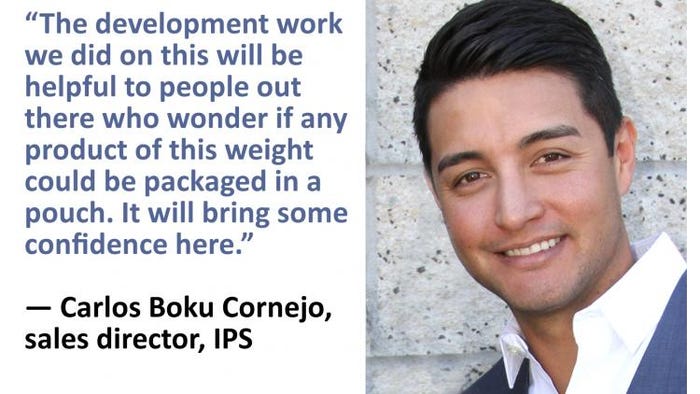
What were some of the challenges in developing the pouch and how did you solve them?
Boku: The biggest challenge was the drop test. Bona’s HDPE refill bottle is like a tank. You could drop it from the top of a roof and it probably would not break because it is so durable.
Adding a flexible package was a concern for Bona. They liked the concept of a pouch but were concerned that a pouch holding 160 ounces wouldn’t survive a shoulder-high or head-high drop test.
So we built the material up. We’re using a 3-ply lamination. We always use nylon for something of this magnitude. The structure is polyethylene (PE)/nylon/linear-low-density polyethylene (LLDPE). The LLDPE is 200 microns, which is extremely thick—about 8 mils. We used that structure for the front and back panel, with a white-based poly, and then the same structure but in clear for the gussets. Total thickness is about 9 mils.
We did multiple drop tests and this can withstand a shoulder- or head-high drop test, which is incredible because of all that weight, especially with having multiple panels and seal areas. We used a special recipe in the polyethylene to withstand the force, the impact. It’s a special blend of PE resins. This was a challenge, but one we were able to overcome with the poly we used.
The development work we did on this will be helpful to people out there who wonder if any product of this weight could be packaged in a pouch. It will bring some confidence here. There is a lot of opportunity for companies to use this model for products of this much weight. Especially in the home care sector, like laundry detergent.
Dan also made a unique corrugated case to hold four pouches. Because the pouches are shaped a little differently, they designed the case to hold them securely. How they designed the box was creative. [Editor's note: See a photo of a single-pouch case on the next page.]
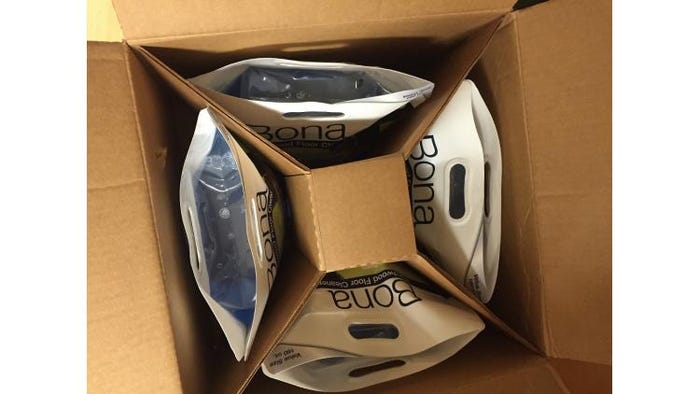
The shipping case holding four pouches for distribution to retail outlets uses an intricate partition to separate and secure the pouches.
On the pouch at the side seals where the gussets join, during manufacturing of the pre-made pouch, you’re sealing through four pretty thick layers of material.
Boku: It’s 9 mil of material each, so that’s 36 mil total. On top of that, there is a matte coating everywhere except the photograph and the two gussets. Bona wanted to keep the image glossy so it would stand out.
But when you apply a certain amount of heat and pressure to a pouch that’s very thick, it can wear the matte coating off the surface of the film and perhaps burn the plastic. So we had to keep several factors in mind when we engineered the material: that it could pass the drop test requirement from head high, and also that it would not melt when sealing this thick of a material, times four panels.
Why use a matte finish then?
Smith: The matte finish is in line with our Bona brand so in was important that we made it work.
Drop tests were done from shoulder/head high because the product is often positioned on the top shelves in the store, right?
Smith: Yes, some of our retailers store/display the product on top shelves.
What tests did you do to ensure the pouch could withstand the pressures of use and shipping without leaking?
Smith: As per our standard operating procedures here at Bona, we performed a variety of drop tests and put the packaged product thru ISTA protocols, which simulate UPS/FedEx shipping.
NEXT: Bottom dispensing
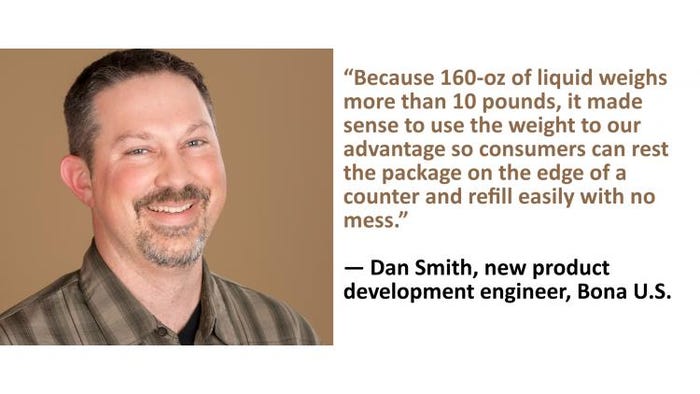
Why add a dispensing spout at the bottom of the pouch? How did you come up with this idea? Most gusseted refill pouches are tipped to pour from a corner spout.
Smith: This was an important part of our testing process. We knew we wanted to improve the consumer experience (that is, make it easy to use), so we challenged the team with re-thinking the refill process. Because 160 ounces of liquid weighs more than 10 pounds, it made sense to use the weight to our advantage so consumers can rest the package on the edge of a counter and refill easily with no mess.
Is the dispenser sealed to the bladder on the pouch in any way or simply friction fit (pushed in)?
Smith: It is a friction fit with three seals between the tap and gland.
Does the fitment lock?
Boku: There’s a valve inside the fitment. When you press down, it releases the valve to dispense the product. But when you stop pressing down on the two dispensing tabs, the valve then shuts and stops the product flow.
How is the dispenser added to the pouch?
Boku: The entire pouch, except for the dispenser and the two handles, is made inline on the pouch machine. That’s the two gussets, the front and back panels, the die cutting of the handles, and the bottom and top tapering [shaping] of the pouch are all done inline.
The dispenser is placed on afterwards. The bladder piece attaches to the pouch and the dispenser part is actually loose. We half-torque on the dispenser piece and ship it that way, meaning not pressed in all the way. Because on the filler, a gripper mechanism will pull off the dispenser so a nozzle can drop in and fill the pouch to the correct weight. Then the mechanism puts the dispenser back in and torques it all the way on. Once the dispenser piece is applied all the way, there’s no way to take it off for filling.
When we did the drop tests, the pouch passed a couple times from head- or shoulder-high. After that, it would start to tear from the material, as opposed to from the dispenser. That’s pretty interesting how secure that whole dispenser area is.
Where is the pouch filled?
Smith: Near our manufacturing facility in North Carolina.
The dispensing tabs on either side make it easy to activate the dispenser with one hand. Was one-handed use an important feature for you?
Smith: Yes. Our current cartridge does not stand up on a counter, so this is an important new feature.
The dispenser is also tamper-evident. Is that an important feature for you?
Smith: Yes. Consumers want the confidence that they are using a product that has not been already opened.
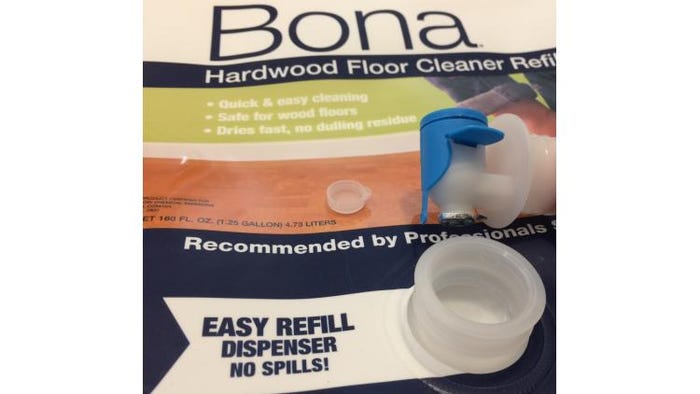
The dispenser is tamper evident: A blue molded piece needs to be removed before the wings on either side can be lifted to open the valve so product can flow. The dispenser also has a foil induction seal and an overcap to minimize drips once the dispenser is opened.
Tell us about the handles in the header.
Boku: The pouch has plastic carrying handles built into it at the top, one on the front and one on the back, for comfort. Otherwise, just die-cut holes would have been too sharp on the fingers.
You can’t really see the handles from the outside until you pick up the package. We didn’t want to make it too obvious. We wanted it to be somewhat of a surprise when people picked up the pouch.
The pouch holds 160 ounces, which is about 10 pounds. Consumers can carry the pouch with two hands, if they wanted to, if they’re not as strong. Or they can carry it with one hand.
The two handles simply pinch together; they don’t snap closed.
There’s no need for the two handles to snap together, right?
Smith: Correct, it is easy for the consumer to put one hand thru both of the handles.
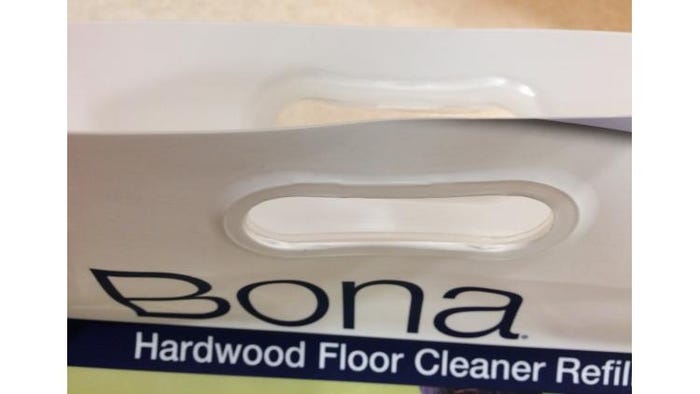
The plastic handles are sealed into the die-cut holes and provide a comfortable carrying feature.
Bona created a special shipping case to secure and stabilize the pouches. Please tell us more about the case.
Smith: We ship our current rigid product four to a case, so we wanted to mirror that for these pouches. We also created a single-pack shipper for Amazon and our own website sales. We tested the packaging to make sure the product arrived without any damage.

Designed for ecommerce sales via Amazon and Bona's website, the shipping case for a single pouch includes a partition to capture and contain the spout, keeping the pouch in place during distribution.
*********************************************************************************************

About the Author(s)
You May Also Like




